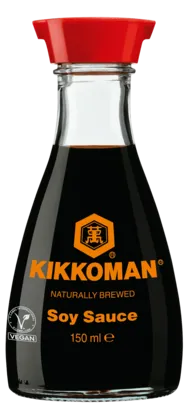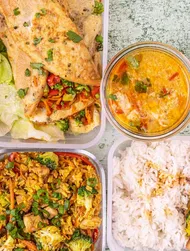Chinese recipes: how to cook Chinese
26. January 2024

Many dishes during this period have a special symbolic meaning. Fish and prawns, for example, symbolise luck and success; jiaozi, kourou and spring rolls represent prosperity; meatballs and sweet rice balls stand for family togetherness, and noodles for long life. Chinese New Year food is a great opportunity for delicious inspiration because Chinese cuisine offers so much variety - and not just for the new year!
Which dishes are typically Chinese?
There is no single Chinese cuisine but various main styles. The diversity of Chinese dishes and cooking is as vast as the country itself - influenced by geographical and climatic differences. Here, we'd like to introduce you to four regional cooking styles:
Shandong
The popular Shandong cuisine from the country's northeast includes many fried and braised dishes and soups. Since Shandong is located along the Yellow River and the coast, fish and seafood such as mussels and abalone are an integral part of the cuisine. The agricultural hinterland is also known for its grain products as well as garlic, onions, aubergines and pak choi. The so-called Lu cuisine is considered the culinary fare of the imperial court.
Sichuan
The subtropical climate and fertile soil create ideal conditions for year-round agriculture, including the cultivation of rice, corn, soy and tea. In the province famous for its Sichuan pepper, ginger, garlic and chilli are also commonly used for seasoning. Things can get spicy! Apart from pickled vegetables, the Sichuanese consume more meat than other regions of the country.
Guangdong
Cantonese cuisine from Guangdong is renowned for its mild sauces, whether hoisin or oyster sauce, sweet and sour or plum sauce. Spices are used sparingly, and preparation methods are usually gentle. The cooking is influenced by various other Chinese provinces, making the food particularly diverse. Locally grown ingredients like potatoes, soybeans and spring onions often find their way into the wok, along with many varieties of meat and, due to the coastal location, fish.
This tradition also includes types of meat that are generally not served in Europe.
Huaiyang
The eastern Chinese province of Jiangsu on the Yellow Sea is the heartland of Huaiyang cuisine. Light soups and fried rice with vegetables and shrimp are staples of the cooking, known for its fresh dishes and often slightly sweet character. Fish, poultry, spinach and bamboo shoots are also popular. Classics include lion's heads (meatballs with crab meat) and lotus root filled with sticky rice.

Chinese classics you should know
Many countries have dishes in their repertoire that are particularly well-known or popular in other countries. When it comes to Chinese food, many people especially tend to think of jiaozi, the delicious stuffed dumplings, mapo tofu with minced meat and Sichuan pepper, and dim sum, small delicacies from bamboo steamers. Peking duck and Peking soup are of course also classics.

Typical ingredients of Chinese cuisine
The ingredients used are as diverse as the flavours. Listing them all would be impossible. However, fans of Chinese food cannot do without the following must-haves:
Basmati rice
This white, slender, long-grain rice is grown at the foot of the Himalayas. It is considered particularly fine and is a favourite for its distinctive aroma. So it's no wonder that Basmati means "the fragrant one".
Mien noodles
Chinese noodles are said to be the oldest in the world. This includes mien noodles, an essential ingredient in many Asian dishes. These versatile wheat noodles are ideal for use in soups and stir-fried dishes.
Soy sauce
Soy sauce is the most important condiment in Asian cuisine for cooking or seasoning. Water, soybeans, wheat and salt - that's all it takes to brew our Kikkoman Soy Sauce. Its full-bodied flavour adds umami-richness to any dish.
Sichuan pepper
The renowned spice from Sichuan, the land of four rivers, is actually the flower buds of a citrus plant. The seed capsules are used like peppercorns, providing an aromatic, tingling spiciness.
Shaoxing wine
Taste-wise, Shaoxing wine is somewhat reminiscent of sherry. It's often enjoyed warm as an aperitif in winter. In addition, it's a popular seasoning in Chinese cuisine and is also suitable for marinating meat.

Chinese recipes for beginners
If you love Asian cuisine but don't have time for elaborate dishes or are hesitant to try them, then you're in luck! Plenty of delicious Chinese recipes are quick and simple to cook. Here are a few ideas for you!
Reimagining Chinese dishes
The classic favourites of Chinese cooking are delicious. But how about adding some variety to your plate with new interpretations? Let our suggestions inspire you, or get creative on your own. Enjoy!








![[Translate to Englisch (UK):] [Translate to Englisch (UK):]](https://www.kikkoman.co.uk/fileadmin/_processed_/9/4/csm_Blogpage_How_To_Master_Velveting_Desktop-Header_f36d5cca18.webp)


![[Translate to Englisch (UK):] [Translate to Englisch (UK):]](https://www.kikkoman.co.uk/fileadmin/_processed_/0/d/csm_928-recipe-page-prawn-and-vegetable-stir-fry-noodles_mobile_78dc5b25bc.webp)
![[Translate to Englisch (UK):] [Translate to Englisch (UK):]](https://www.kikkoman.co.uk/fileadmin/_processed_/c/d/csm_1039-recipe-page-Easy-Carrot-soup_mobile_7366116d92.webp)
![[Translate to Englisch (UK):] [Translate to Englisch (UK):]](https://www.kikkoman.co.uk/fileadmin/_processed_/c/5/csm_MainDishes_recipe-collection_desktop_2x_ef5962097e.webp)
![[Translate to Englisch (UK):] [Translate to Englisch (UK):]](https://www.kikkoman.co.uk/fileadmin/_processed_/b/e/csm_1101-recipe-page-Authentic-Japanese-soy-sauce-ramen_mobile_6bf05afcae.webp)
![[Translate to Englisch (UK):] [Translate to Englisch (UK):]](https://www.kikkoman.co.uk/fileadmin/_processed_/e/b/csm_918-recipe-page-pumpkin-hummus_mobile_d372eb934b.webp)




